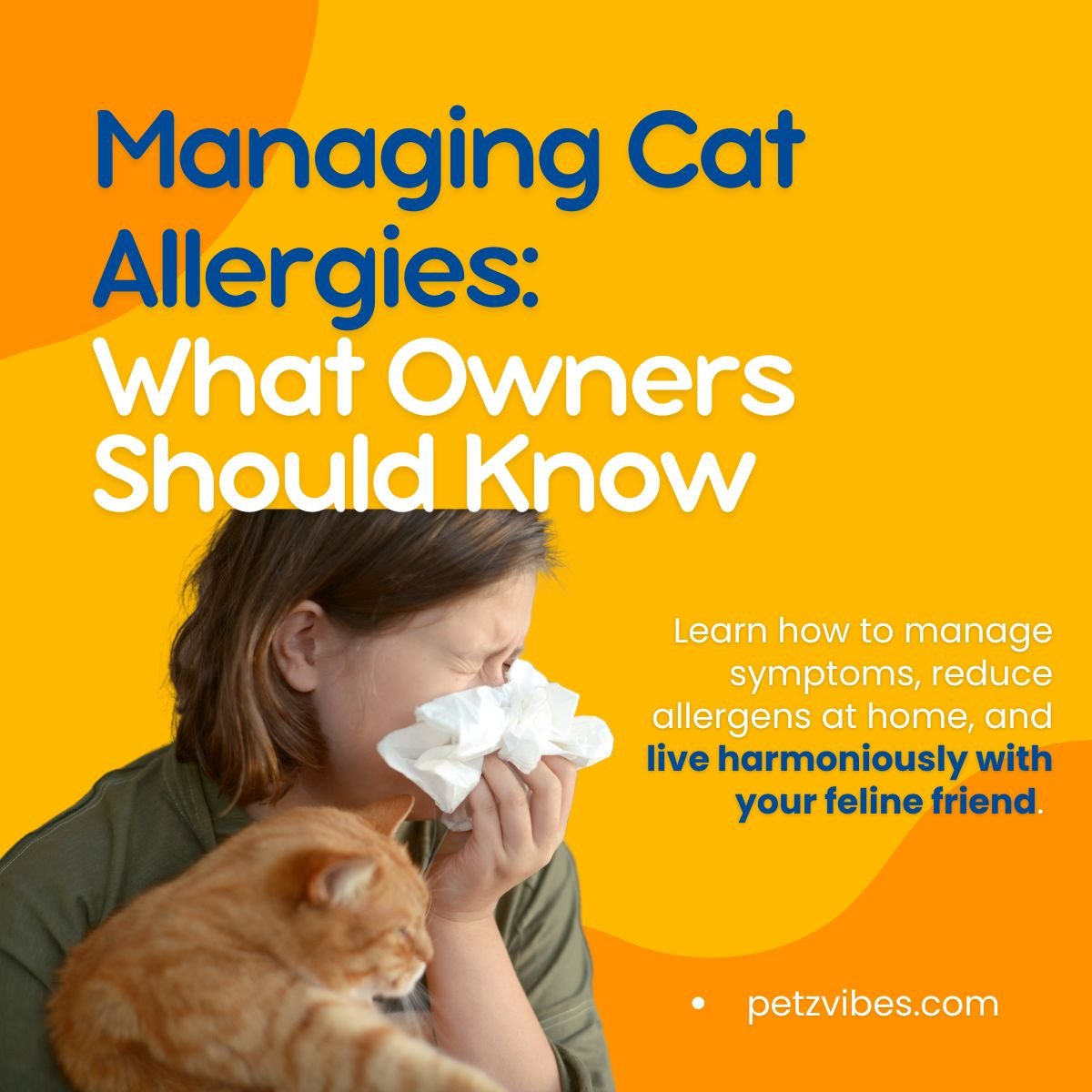Managing cat allergies doesn’t have to mean giving up your beloved pet. If you adore your feline companion but suffer from sneezing, itchy eyes, or a runny nose every time they curl up in your lap, you’re not alone—up to 20% of people are allergic to cats. The good news? With the right strategies, you can significantly reduce symptoms and enjoy a happy, sniffle-free life with your furry friend.
In this guide, we’ll explain exactly how cat allergies work, proven ways to minimize exposure to allergens, and the best treatments—from home remedies to medical solutions. Whether you’re a long-time cat owner or considering adopting one, these tips will help you breathe easier (literally) while keeping your pet close.
Key Takeaways: Managing Cat Allergies Effectively
-
Cat allergies are triggered by proteins (Fel d 1) in dander, saliva, and urine, not fur itself.
-
Symptoms vary (sneezing, asthma, eczema) and can develop at any age, even after years with cats.
-
Diagnosis is essential—skin prick or blood tests confirm allergies and rule out other triggers.
-
Reduce exposure with HEPA filters, weekly cat baths, and strict “allergy-free zones” (like bedrooms).
-
Medications help (antihistamines, nasal sprays), but consult a doctor first, especially for children.
-
Long-term solutions exist: Allergy shots (immunotherapy) can build tolerance over time.
-
Hypoallergenic breeds (e.g., Siberian, Balinese) produce fewer allergens but aren’t 100% safe.
-
Rehoming may be necessary for severe cases—always prioritize health and ethical pet placement.
Understanding Cat Allergies: What Triggers Your Symptoms?
Managing cat allergies starts with knowing the real culprit—not cat hair, but a protein called Fel d 1. This allergen is found in your cat’s saliva, skin flakes (dander), and urine, and it’s lightweight enough to float in the air for hours. When inhaled or touched, it can trigger an overactive immune response, leading to frustrating symptoms like:
-
Sneezing, congestion, or a runny nose (classic hay fever signs)
-
Itchy, watery eyes (allergic conjunctivitis)
-
Skin rashes or hives (especially after scratches or licks)
-
Asthma flare-ups (wheezing or shortness of breath in sensitive individuals)
Key Insight: Even “hairless” cats (like Sphynx) produce Fel d 1, so no breed is 100% hypoallergenic. However, some produce fewer allergens than others (more on that later).
How Cat Allergies Develop: Why You Might React Suddenly
Did you know you can develop a cat allergy at any age—even if you’ve lived with cats for years? Unlike seasonal allergies, which come and go, cat allergies often worsen with repeated exposure. Here’s why:
-
The Immune System’s Role
-
Your body mistakes harmless proteins (Fel d 1) as a threat.
-
It releases histamines, causing inflammation and symptoms.
-
-
The Dander Dilemma
-
Contrary to popular belief, cat hair isn’t the problem—it’s the dander (dead skin cells) clinging to it.
-
Dander spreads easily via furniture, clothing, and even HVAC systems.
-
-
Delayed Reactions
-
Some people react immediately; others experience gradual symptoms over months or years.
-
Children exposed to cats early may develop tolerance or suddenly react later in life.
-
Pro Tip: If you’ve noticed new allergy symptoms, don’t immediately blame a new cat. Other triggers (dust mites, pollen) could be the real cause, so testing is critical.
Diagnosing Cat Allergies: How to Know for Sure
Suspect your cat is the problem? An allergist can confirm it with these tests:
1. Skin Prick Test (Most Common)
-
Tiny amounts of cat allergen are pricked into your skin.
-
If you’re allergic, the site becomes red, swollen, or itchy within 15 minutes.
-
Fast, accurate, and usually covered by insurance.
2. Blood Test (IgE Testing)
-
Measures antibodies to cat allergens in your blood.
-
Ideal if you can’t stop antihistamines before testing or have severe skin conditions.
Why Testing Matters:
-
Rules out other allergens (mold, dust mites) that mimic cat allergies.
-
Helps tailor your allergy management plan, whether it’s medication, immunotherapy, or lifestyle changes.
Did You Know?
-
20-30% of people with allergies react to cats, but only 10% of cat owners give up their pets due to allergies—proof that management works!
Introducing a New Cat When You Have Allergies: A Step-by-Step Plan
Are you thinking of adopting but worried about allergies? This strategic approach helps minimize risks while keeping your health (and the welfare of your new pet) in mind.
Pre-Adoption Preparation
-
Spend Extended Time with the Breed
-
Visit shelters/breeders multiple times
-
Rub your face on the cat’s fur (yes, really!) to test reactions
-
-
Medical Prep
-
Start antihistamines 2 weeks pre-adoption
-
Ask your allergist about nasal spray pre-treatment
-
-
Home Readiness
-
Set up HEPA purifiers in advance
-
Create allergy-safe zones (especially bedrooms)
-
The First 30 Days: Critical Period
-
Bathing Schedule:
-
Week 1: Professional groomer bath
-
Thereafter: Every 3 weeks with hypoallergenic shampoo
-
-
Cleaning Routine:
-
Daily: Vacuum with HEPA filter
-
Weekly: Wash all bedding in 130°F+ water
-
-
Monitor Symptoms:
-
Keep an allergy journal tracking reactions
-
Long-Term Success Strategies
-
Designate a non-allergic family member for:
-
Litter box duty
-
Brushing (outdoors is best)
-
-
Consider female or light-colored cats (studies suggest they produce less Fel d 1)
Red Flags to Watch For:
If you experience asthma attacks, chronic sinus infections, or eczema flares despite these measures, consult your allergist immediately about next steps.
Managing Cat Allergies: Effective Strategies for a Sneeze-Free Home

Living with cat allergies doesn’t mean you have to choose between your health and your feline friend. With the right approach, you can significantly reduce allergens and enjoy life with your pet, without constant sneezing or itchy eyes. Here’s how to create an allergy-friendly home while keeping your cat happy and healthy.
1. Keep Your Living Space Clean (The Right Way)
Cat dander clings to surfaces, so a thorough cleaning routine is essential. But not all cleaning methods are equally compelling:
-
Vacuum Smartly: Use a HEPA-filter vacuum 2-3 times weekly on carpets, furniture, and cat beds. (Dander lingers in fabrics!)
-
Wash Bedding in Hot Water (130°F+): This kills allergens in sheets, blankets, and even your cat’s favorite sleeping spots.
-
Dust with Damp Cloths: Dry dusting spreads allergens—use a microfiber cloth + allergen spray instead.
-
Invest in an Air Purifier: A true HEPA air purifier (look for CADR-rated models) can remove up to 99.97% of airborne allergens.
Pro Tip:
-
Groom your cat before cleaning to minimize dander spreading.
-
Replace carpets with hardwood/tile where possible—dander sticks harder to fibers.
2. Create an Allergy-Free Zone (Your Bedroom is Key!)
Your bedroom should be a sanctuary, not an allergy battleground. Here’s how to make it a cat-free zone:
-
Keep the Door Closed: Prevent your cat from bringing in dander on their fur.
-
Use Hypoallergenic Bedding: Dust-mite-proof covers add an extra barrier.
-
Wash PJs Frequently: Allergens cling to sleepwear—change them every 2-3 days.
Did You Know?
-
Dander levels take 3-6 months to drop in a room after a cat leaves.
-
Air purifiers + regular cleaning can speed up the process.
3. Bathe Your Cat (Yes, It’s Possible!)
Bathing your cat reduces active allergens by washing away saliva and dander. But cats hate water, so here’s how to do it safely:
-
Frequency: Every 4-6 weeks (over-bathing dries their skin, increasing dander).
-
Use a Hypoallergenic Shampoo: Look for oatmeal or aloe-based formulas.
-
Alternatives: If baths are impossible, try waterless cat shampoo or allergen-reducing wipes.
Warning:
-
Never use human shampoo—it disrupts their skin pH.
-
Reward with treats to make baths less stressful.
4. Choosing a Hypoallergenic Cat Breed (Do They Really Exist?)
No cat is 100% hypoallergenic, but some breeds produce less Fel d 1 protein, making them better for allergy sufferers:
Top 5 Low-Allergen Cat Breeds
| Breed | Why It’s Better for Allergies |
|---|---|
| Siberian | Produces less Fel d 1 in saliva. |
| Balinese | Single coat = less dander. |
| Sphynx | Hairless, but still produces dander (needs frequent baths). |
| Russian Blue | Thick coat traps dander better. |
| Bengal | Short fur + lower grooming saliva. |
Critical Tip:
-
Spend time with the breed first—individual cats vary in allergen levels.
-
Female cats generally produce less Fel d 1 than males.
Traveling With Cats When You Have Allergies
Managing cat allergies while traveling requires extra planning, whether bringing your pet along or staying in cat-friendly spaces. These strategies minimize exposure when you’re away from your controlled home environment.
Pre-Travel Prep
-
2 Days Before Departure:
-
Bathe your cat with hypoallergenic shampoo
-
Pack portable HEPA purifiers (for hotel rooms/cars)
-
Car Travel Tips
-
Use hard-sided carriers (less dander leakage than soft carriers)
-
Cover seats with washable throws (launder immediately after trips)
-
Run car air purifiers (look for 12V HEPA models)
Hotel Stay Strategies
-
Request pet-free rooms (they’re deep-cleaned more aggressively)
-
Wipe down surfaces with allergen-neutralizing sprays upon arrival
-
Keep your allergy medication kit easily accessible
Medications for Cat Allergies: When Prevention Isn’t Enough
Managing cat allergies effectively sometimes requires medical intervention. While reducing dander and creating allergy-free zones help, medications can be a game-changer for persistent symptoms. Here’s a breakdown of the most common cat allergy treatments, how they work, and what to discuss with your allergist.
1. Antihistamines: Fast-Acting Symptom Relief
Best for: Sneezing, itchy eyes, runny nose, and skin rashes.
-
How They Work: Block histamine (the chemical your body releases during an allergic reaction).
-
Common Options:
-
Over-the-counter (OTC): Cetirizine (Zyrtec), Loratadine (Claritin), Fexofenadine (Allegra)
-
Prescription-strength: Levocetirizine (Xyzal)
-
-
Key Notes:
-
Non-drowsy formulas (like Allegra) are ideal for daytime use.
-
Older antihistamines (e.g., Benadryl) can cause drowsiness—best for nighttime relief.
-
Pro Tip:
-
Start taking them before exposure (e.g., visiting a home with cats).
-
Nasal antihistamine sprays (Astepro, Patanase) target congestion faster than pills.
2. Nasal Corticosteroids: Long-Term Congestion Relief
Best for: Stuffy nose, sinus pressure, and post-nasal drip.
-
How They Work: Reduce inflammation in nasal passages (unlike antihistamines, which block histamine).
-
Common Options:
-
Fluticasone (Flonase)
-
Triamcinolone (Nasacort)
-
Mometasone (Nasonex)
-
-
Key Notes:
-
Take 1-2 weeks of regular use for full effect.
-
Safe for long-term use (unlike decongestant sprays, which can cause rebound congestion).
-
Did You Know?
-
Combining a nasal steroid + antihistamine can be more effective than either alone.
3. Allergy Shots (Immunotherapy): A Long-Term Solution
Best for: Moderate to severe allergies where medications aren’t enough.
-
How They Work: Gradually desensitize your immune system to cat allergens through small, increasing doses.
-
Process:
-
Build-up phase: Weekly shots for 3-6 months.
-
Maintenance phase: Monthly shots for 3-5 years.
-
-
Effectiveness:
-
60-80% of patients see significant improvement.
-
It can reduce or eliminate the need for medications over time.
-
Who Should Consider Them?
-
People who can’t avoid cats (e.g., due to family pets).
-
Those who don’t respond well to meds or experience side effects.
Alternative Option:
-
Sublingual immunotherapy (SLIT): Drops or tablets under the tongue (currently only for dust/mold/pollen, but cat options are in development).
When to See an Allergist
If OTC meds aren’t controlling symptoms, consult a specialist. They can help you:
-
Confirm cat allergies (vs. other triggers).
-
Personalize treatment (e.g., combining meds + lifestyle changes).
-
Explore advanced options like biologics (for severe asthma linked to cat allergies).
Natural Remedies for Cat Allergies: Complementary Approaches to Try
For those seeking drug-free solutions or extra support alongside medications, these science-backed natural approaches may help reduce cat allergy symptoms. While not replacements for medical treatment, they can be part of a holistic management plan.
1. Saline Nasal Irrigation (Neti Pot)
-
How it helps: Flushes out inhaled allergens from the nasal passages
-
Protocol: Use distilled or boiled water 1- 2x daily during flare-ups
-
Pro tip: Add a pinch of baking soda to neutralize the sting
2. High-Quality Air Filtration
-
HEPA air purifiers: Capture 99.97% of airborne dander
-
Placement matters: Put units in bedrooms + main living areas
-
Bonus: Look for purifiers with activated carbon filters to neutralize odors
3. Quercetin Supplements
-
Natural antihistamine found in apples, onions, and tea
-
Dosage: 500mg 2- 3x daily (consult doctor first)
-
Caveat: May interact with blood thinners
4. Probiotics for Immune Support
-
Emerging research suggests gut microbiome balance affects allergic responses
-
Specific strains: Look for Lactobacillus rhamnosus GG
-
Food sources: Yogurt, kefir, sauerkraut
5. Omega-3 Fatty Acids
-
Anti-inflammatory effects may help reduce reactivity
-
Sources:
-
For humans: Fish oil supplements
-
For cats: Omega-3 enriched cat food (reduces dander quality)
-
6. Home Environment Tweaks
-
Humidity control: Maintain 40-50% humidity (too dry spreads dander, too damp grows mold)
-
Washable decor: Replace curtains with blinds, use leather/vinyl furniture
-
Cat grooming wipes: Wipe down your cat between baths
Important Safety Notes
-
Essential oils: Many are toxic to cats (especially tea tree, eucalyptus)
-
Herbal remedies: Some (like butterbur) have liver risks
-
Always consult your allergist before starting supplements
Realistic Expectations:
*”While these methods may provide 20-30% symptom improvement for some, they work best combined with medical treatments and thorough cleaning practices.”*
Final Thoughts
Managing cat allergies is possible, even without rehoming your pet. While antihistamines and nasal sprays offer quick relief, allergy shots provide a long-term solution for lasting tolerance. Work with your doctor to find the right balance of prevention, medication, and immunotherapy for your needs.
Next Steps:
-
Track your symptoms to discuss with your allergist.
-
Ask about combo therapies (e.g., antihistamine + nasal spray).
-
Consider immunotherapy if allergies disrupt daily life.
Kids & Cat Allergies: Special Considerations for Families
Managing cat allergies in children requires extra care—their developing immune systems react unpredictably, and early exposure can help build tolerance or trigger lifelong sensitivities. As a parent, understanding these nuances enables you to make informed decisions about feline companionship while safeguarding your child’s health.
The Allergy Paradox: Early Exposure Risks vs. Benefits
-
Potential Benefit (Hygiene Hypothesis):
Studies suggest infants exposed to cats may develop fewer allergies overall as their immune systems learn tolerance.-
Key finding: Babies in homes with cats show 30% lower odds of pet allergies by age 5 (Journal of Allergy and Clinical Immunology, 2022).
-
-
Potential Risk:
For genetically predisposed kids, early exposure may accelerate allergic reactions, including:-
Chronic sneezing/eczema
-
Asthma exacerbations (wheezing, nighttime coughing)
-
Actionable Tip:
If your family has a history of asthma or eczema, consult a pediatric allergist before bringing home a cat.
Red Flags: When to Suspect Cat Allergies in Children
Watch for these signs after cat exposure:
-
Respiratory: Persistent runny nose, wheezing, or “allergic shiners” (dark under-eye circles)
-
Skin: Red, itchy patches where cats licked/scratched
-
Behavioral: Avoiding playtime with the cat or rubbing eyes excessively
Critical Step:
Don’t assume symptoms are “just a cold”—recurrent issues warrant allergy testing.
Diagnosis & Safe Treatment for Kids
1. Pediatric Allergy Testing
-
Skin prick tests: Fast, minimally invasive (results in 15 minutes)
-
Blood tests (IgE): Better for kids with eczema or a fear of needles
2. Child-Safe Medications
| Medication Type | Examples | Key Notes |
|---|---|---|
| Antihistamines | Children’s Zyrtec, Claritin | Non-drowsy formulas for daytime |
| Nasal sprays | Flonase Sensimist (ages 2+) | Steroid-free options available |
| Emergency | Pediatric EpiPen (for severe reactions) | Rare but critical for anaphylaxis |
Pediatrician Warning:
*”Never give under-2s allergy meds without medical supervision. Drowsy formulations can impair breathing in toddlers.”*
Prevention Strategies for Cat-Owning Families
-
Hand Hygiene: Teach kids to wash their hands immediately after petting the cat.
-
Face Boundaries: Enforce “no kissing the cat” rules to reduce saliva exposure.
-
Safe Zones: Keep the cat in the child’s bedroom (use HEPA filters there).
-
Grooming Duty: Assign brushing to a non-allergic adult (outdoors if possible).
Pro Tip:
*Start allergy meds 1-2 weeks before adopting a cat if your child has mild sensitivities.*
When to Reconsider Cat Ownership
While managing cat allergies is possible for many kids, reconsider if your child shows:
-
Frequent asthma attacks requiring hospitalization
-
Eczema that worsens with pet exposure
-
Poor sleep quality due to nasal congestion
Compassionate Alternative:
Consider fostering a cat in the short term to assess reactions before committing.
When to Consider Rehoming Your Cat (And How to Do It Responsibly)
Managing cat allergies successfully isn’t always possible, and in severe cases, rehoming may become the most compassionate choice for you and your pet. While this decision is heartbreaking, these guidelines help ensure it’s handled ethically if avoidance strategies, medications, and immunotherapy fail.
Signs Rehoming Might Be Necessary
-
Uncontrollable asthma attacks or recurrent sinus infections
-
Failed allergy shots after 1+ years of treatment
-
Declining quality of life for you or your cat (e.g., constant confinement to one room)
How to Rehome Responsibly
-
Work With Reputable Organizations
-
Contact breed-specific rescues (even for mixed breeds)
-
Partner with no-kill shelters that conduct behavioral assessments
-
-
Screen Potential Adopters Thoroughly
-
Ask for veterinary references
-
Require a trial period before permanent adoption
-
-
Avoid Risky Options
-
Never surrender to public animal control (high euthanasia risk)
-
Reject Craigslist or Facebook Marketplace requests without vetting
-
Essential Safety Notice for All Readers
⚠️ Always consult your physician or allergist before starting any allergy medication—prescription, over-the-counter, or natural remedies. What works safely for one person may cause dangerous reactions in another due to:
-
Individual health factors (asthma, pregnancy, other medications)
-
Proper dosing requirements (especially critical for children)
-
Potential test interference (meds can alter allergy test accuracy)
-
Severity assessment (some symptoms require advanced treatment)
Conclusion
Conclusion: Living Happily With Cats—Despite Allergies
Managing cat allergies balances prevention, treatment, and realistic expectations. While symptoms can be frustrating, many cat lovers find relief through a combination of:
-
Home adjustments (cleaning, air purifiers)
-
Medical support (personalized treatment plans)
-
Wise cat choices (low-dander breeds, grooming routines)
Remember:
-
Early action matters. Addressing symptoms quickly prevents worsening reactions.
-
You’re not alone. Millions of allergy sufferers coexist with cats successfully.
-
Professional guidance is key. Work with your allergist to tailor solutions.
You and your feline friend can enjoy a healthy, sneeze-free life together with the right strategies.
FAQ: Cat Allergies Answered
1. Can I outgrow a cat allergy?
-
It’s rare but possible. Some children develop tolerance; adults usually don’t. Immunotherapy (allergy shots) increases the chances.
2. Do hypoallergenic cats exist?
-
No breed is 100% hypoallergenic, but some (like Siberians) produce less Fel d 1 protein. Always spend time with a cat before adopting.
3. How often should I bathe my cat to reduce allergies?
-
Every 4–6 weeks with hypoallergenic shampoo. Overbathing dries their skin, increasing dander.
4. Are air purifiers worth it?
-
Yes! HEPA filters remove 99.97% of airborne allergens. Please place them in bedrooms and living areas.
5. Can cat allergies cause asthma?
-
Yes. Cat dander is a common asthma trigger. Seek immediate help for wheezing or chest tightness.
6. What’s the fastest way to relieve symptoms?
-
Antihistamines (like Zyrtec) are used for quick relief, but nasal corticosteroids (e.g., Flonase) work better in the long term.
7. Should I rehome my cat if I’m allergic?
-
This is a last resort. First, try all management strategies. If health risks persist, consult a no-kill shelter or breed-specific rescue.
8. Are natural remedies effective?
-
Some (like saline rinses) help mildly. Avoid essential oils—many are toxic to cats.
9. Can diet reduce my cat’s allergens?
-
Emerging research suggests omega-3 fatty acids in cat food may improve skin health and reduce dander.
10. How long do allergy shots take to work?
-
3–6 months for initial relief; 3–5 years for full results. Commitment is key!
Resources
- Mayo Clinic – Pet Allergy Diagnosis & Treatment: https://www.mayoclinic.org/diseases-conditions/pet-allergy/diagnosis-treatment/drc-20352198
- American College of Allergy, Asthma & Immunology (ACAAI) – Pet Allergies: https://acaai.org/allergies/allergic-conditions/pet-allergies
- Allergy UK – Cat Allergy Factsheet: https://www.allergyuk.org/resources/cat-allergy-factsheet/






